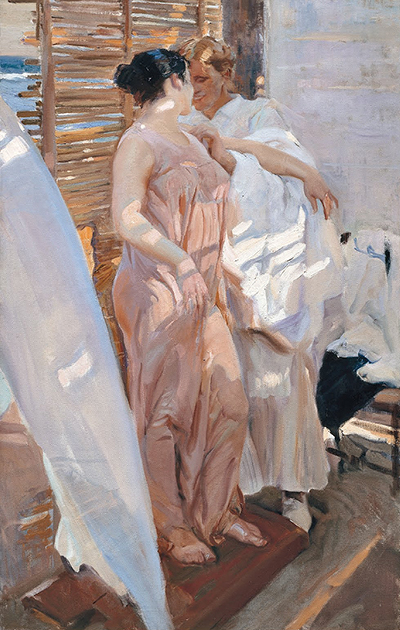The Pink Robe is a 1916 work by the Valencian painter Joaquim Sorolla i Bastida. The artwork, which is also known as Leaving the Bathroom or After the Bathroom is painted in oil on canvas with dimensions of 208 × 126.50 cm and currently hangs in the Sorolla Museum.
Pink robes were common on Valencian beaches in the late 19th and early 20th centuries. It was customary for the children of fishermen and workers to bathe naked until the age of four or five, at which age, although boys continued to bathe naked until adolescence, girls wore a pink or white robe. Sorolla painted several canvases with this same theme but perhaps it is in this work of 1916, one of his masterpieces, where the artist reaches his greatest maturity by fully establishing himself as the "painter of light".
Sorolla's repeated characterization as "the painter of light" finds full justification in this mature work. Natural light, its effect on forms, on reality, and more importantly, on the perception we have of it, focused the attention of the Valencian painter throughout his artistic career. Backlight, natural, direct, filtered, or reflected light. Sunlight in all its forms is cited on the surface of oil worked with large accurate strokes; whose speed seems to chase the transience of the imprisoned light moment.
The large size of the canvas piece of art (which measures more than 2 metres high by almost 1.30 metres wide) suggests that Sorolla was influenced by the commission of the Hispanic Society of New York, in which he had been working since 1912 making large murals. The piece of art reflects an everyday scene inside a hut near the shore of the beach. An older woman helps a younger one take off her pink robe still wet from her recent bathe. The silhouettes of the women cut back in the light, the folds of their clothes reminiscent of the "wet cloths" of Greek sculptures and the bodies of round shapes in a pose that brings to mind the figures of the Three Graces, give the work the dignity of a work of Classical Greece. The light that floods everything enters from the outside between the reed, by the openings of the ceiling, it filters between fabrics, it is reflected in the white tunics and it illuminates the gust and to the women in all modalities.
Against the light reflected directly filtered natural light all variants are shaped by Sorolla on this canvas to force fast brushstrokes, accurate shooting and they seem to want to retain the ephemeral lightness of the moment. The physical power and naturalness of the figures transcribe the painter's own optimism and his confidence in the common people as the regenerative and evolutionary engine of the country. Sorolla guides us to this reality with an approach in which the same instantaneous, sincere, and direct naturalism prevails with which he tries to capture in the brushes the lighting effects that he offers to our eyes. Similar to other paintings by Sorolla, the scene in this work creates a strong feeling of physical well-being, the spontaneous delight of the abundance of nature, the sun, the sea breeze, and the water; and of the intense pleasure, the painter finds in capturing on canvas the shifting and fleeting changes in light.




